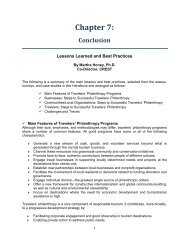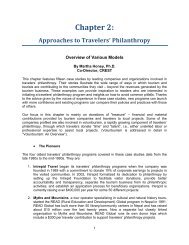Travelers' Philanthropy Handbook - Center for Responsible Travel
Travelers' Philanthropy Handbook - Center for Responsible Travel
Travelers' Philanthropy Handbook - Center for Responsible Travel
You also want an ePaper? Increase the reach of your titles
YUMPU automatically turns print PDFs into web optimized ePapers that Google loves.
deciding whether to donate, but rather who either feels a self-imposed obligation or who hasbeen inspired by the example of her/his travel company to help. “No one” was the standardreply to the “who would disapprove” question.• Tips <strong>for</strong> Making a More Successful “Offer”It is impossible to suggest the actual wording you should use in making your request since thecontext and interpersonal relationships that you have established with your customers will bethe most important factor. In addition, the content and tone of the appeal will differ from case tocase because of the variation in the experiences different operators provide their clients.However, if you’ve succeeded in delivering an experience that bonds your customers to thedestination, you have prepared them <strong>for</strong> the offer to act philanthropically. In this scenario, thewords you use and the tone you adopt in making your offer will usually come easily to you.Guides and interpreters play an especially important role in this process since the bondtravelers develop—both with the company and the place—is heavily influenced by thecharacter and ethos of their guide.How guides interpret the setting andinteract with their customers, howwell they allow the visitors to get toknow them personally, and howpositively their verbal and non-verbalbehavior reflects on the company ororganization they represent, can allhave a strong determining affect on atraveler’s philanthropic impulse.Lindblad guests in Galapagos. Credit: Sam HamSome operators feel that thetravelers’ experience in a destination should be sufficient to inspire a philanthropic act. In otherwords, they feel that if they’ve provided an outstanding travel experience, they needn’t sayanything more to their customers other than letting them know that there is an opportunity togive. In this approach, tourists are simply provided a list of donor organizations that they canchoose to give to (or a brochure that describes each organization and the kinds of local projectsit supports). The role of the tourists at that point is to decide whether and how much to give toeach organization.I see nothing inherently wrong with this approach, but my experience tells me that greatersuccess comes from more targeted communications, delivered in a more strategic way. Asdescribed in the previous pages, Lindblad’s approach was first to identify the reasons theirguests would be inclined to give, the reasons they might be reluctant to give, and the socialinfluences their guests might be subject to.Using this in<strong>for</strong>mation, a communication strategy was developed in which key messages aredelivered to their guests over the course of a seven-day experience, all of which lead to theoffer, which is delivered to the guests the next-to-last night of their tour in the <strong>for</strong>m of a simplebrochure placed in their cabins.In addition to the printed materials that guests see while aboard their ships in Galapagos andBaja, the two campaigns also include their materials that guests receive in the mail after145















